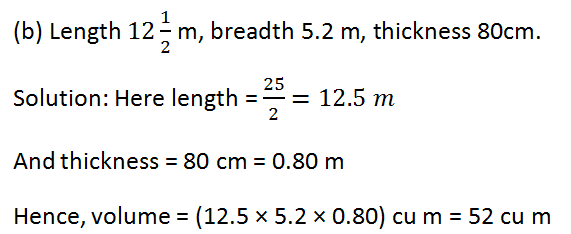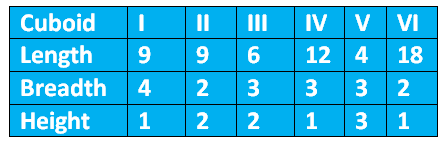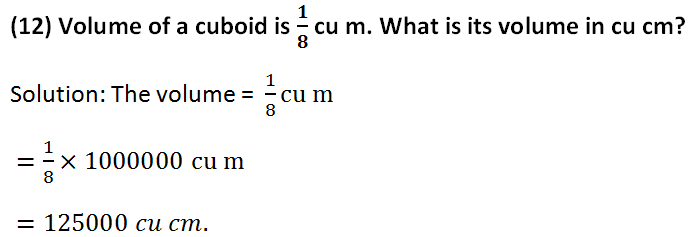S. K. Gupta Anubhuti Gangal Class 5 Math Sixteenth Chapter Volume Exercise 54
EXERCISE 54
(1) Find the volume of each solid and write the unit with your answer.


Solution: (a) Volume = (12 × 12 × 10) cu cm = 1440 cu cm
(b) Volume = (2.1 × 5 ×1.2) cu cm = 12.6 cu cm
(c) Volume = (3.8 × 2 × 5) cm3 = 38 cm3
(d) Volume = (1.2 × 1.2 × 1.2) cm3 = 1.728 cm3
(2) For a cuboid, copy and complete the table:


(3) Find the volume of the following cubes:
(a) Edge 4 cm
Solution: Volume = (4 × 4 × 4) cu cm = 64 cu cm
(b) Edge 5 cm
Solution: Volume = (5 × 5 × 5) cu cm = 125 cu cm
(c) Edge 1.1 cm
Solution: Volume = (1.1 × 1.1 × 1.1) cu cm = 1.331 cu cm
(d) Edge 70 mm
Solution: Volume = (70 × 70 × 70) cu cm = 343000 cu cm
(e) Edge 80 mm
Solution: Volume = (80 × 80 × 80) cu mm = 512000 cu mm
(f) Edge 4.3 m
Solution: volume = (4.3 × 4.3 × 4.3) cu m = 79.507 cu m
(4) A 100-centimeter cube is the same size as a 1-meter cube. How many cubic centimeters make 1 cubic meter?
Solution: Volume of 1 cubic meter = (100 × 100 × 100) cu cm = 1000000 cu cm
(5) Which has the greater volume: box that measure 10 cm by 6 cm by 4 cm or one that measures 6 cm by 6 cm by 7 cm?
Solution: Volume of first box = (10 × 6 × 4) cu cm = 240 cu cm
Volume of second box = (6 × 6 × 7) cu cm = 252 cu cm
(6) A heap of wood is pile 5 dm wide, 9 dm long, and 3 dm high. What is the volume of the heap of wood?
Solution: The required volume of the heap = (5 × 9 × 3) cu dm = 135 cu dm
(7) Find the volume of rectangular solids whose dimensions are as followers:
(a) Length 15 m, breadth 12 m, thickness 75 cm.
Solution: Here, Thickness = 75 cm = 0.75 m
Hence, volume = (15 × 12 × 0.75) cu m = 135 cu m


(8) Calculate the volume of air in six-room house, if the height of each room is 3 m, and the length and widths of the rooms, in meters, are as given by following table:


Solution: Volume of room A = (9 × 5 × 3) m3 = 135 m3
Volume of room B = (4 × 4 × 3) m3 = 48 m3
Volume of room C = (5 × 6 × 3) m3 = 90 m3
Volume of room D = (6 × 4 × 3) m3 = 72 m3
Volume of room E = (8 × 4 × 3) m3 = 96 m3
Volume of room F = (3 × 2 × 3) m3 = 18 m3
Hence, the total volume is 459 cu m.
(9) Sameer has 80 one-centimeter cubs. Which of these cuboids could he build?
(a) 6 cm long, 5 cm wide, 4 cm high
Solution: Volume = (6 × 5 × 4) cu cm = 120 cu cm
(b) 8 cm long, 5 cm wide, 2 cm high
Solution: Volume = (8 × 5 × 2) cu cm = 80 cu cm
(c) 10 cm long, 4 cm wide, 5 cm high
Solution: volume = (10 × 4 × 5) cu cm = 200 cu cm
(d) 6 cm long, 7 cm wide, 2 cm high
Solution: Volume = (6 × 7 × 2) cu cm = 84 cm
(e) 7 cm long, 5 cm wide, 2 cm high
Solution: Volume = (7 × 5 × 2) cu cm = 70 cu cm
(f) 10 cm long, 4 cm wide, 2 cm high
Solution: Volume = (10 × 4 × 2) cu cm = 80 cu cm
(10) Write the length, breadth and height and a cube has an edge of 6 cm. Which one has greater volume?


(11) A cuboid is 6 cm long, 3 cm wide and 3 cm high and cube has an edge of 6 cm. Which one has greater volume?
Solution: Volume of the cuboid = (6 × 3 × 3) cu cm = 54 cu cm
Ans volume of the cube = (6 × 6 × 6) cu cm = 216 cu cm


(13) The floor of a class room is shaped as shown on the right.
(a) What is the perimeter of the floor?
Solution: Perimeter of the floor = [2 × (15+10)] m = (2 × 25) m = 50 m
(b) What is the floor area of the room?
Solution: Area of the floor = (15 × 10) sq m = 150 sq m
(c) If the height of the room is 8 m, how many cubic meters of space is in the room?
Solution: The required cubic meters = (15 × 10 × 8) cu m = 1200 cu m
(14) One centimeter, one square centimeter and one cubic centimeter are different measurements. Why?
Ans: One centimeter denotes length, one square centimeter denotes area and one cubic centimeter denotes volume.
(15) A trench was 30 m long, 2 m wide and 2 m deep. How many cubic meters of earth were removed to dig the trench?
Solution: The required cubic meters = (30 × 2 × 2) cu m = 120 cu m
(16) Complete the following table:


Solution: (a) Height = [24 ÷ (4 × 2)] cm = 3 cm
(b) Height = [30 ÷ (5 × 3)] cm = 2 cm
(c) Length = [2100 ÷ (70 × 5)] mm = 6 mm
(d) Breadth = [2.4 ÷ (8 × 0.5)] cm = 0.6 cm
(e) Length = [1.04 ÷ (4 × 0.05)] mm = 5.2 mm
Leave a Reply